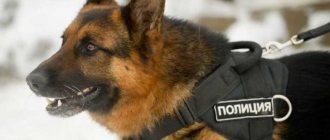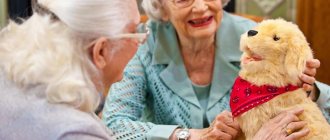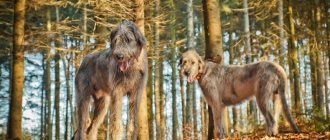The earliest historically recorded use of dogs in battle was 600 BC. If dogs once worked as messengers, wore suicide vests, or sniffed out the enemy, today they are full-fledged members of the team, carrying out extremely important missions.
Interesting Which dogs are the most popular in different countries: map
K9 (canine categories) - from childhood they are trained for various tasks: from attacking the enemy to landing from a military helicopter. Since they perform some tasks on an equal basis with people, they have the same rights.
In many countries, you can get a fine for insulting a service dog , and if you hit him, you can not only feel the death grip of his jaw, but even go to jail.
Typically, German or Belgian Shepherds, Bloodhounds, Dutch Shepherds and Golden Retrievers are recruited. Service life of dogs: from 6 to 9 years. Such “workers” can resign only in the event of injury, illness or death.
The famous Trakr dog that saved people during the September 11 terrorist attack
A German shepherd named Trakr and his partner James Symington were working in a search and rescue unit. In addition to looking for lost people, Trakr also sniffed out contraband.
Trakr and James Symington / Photo Getty Images
During his service, he was able to recover more than $1 million worth of prohibited goods. But this is not why he is remembered by the world.
In 2001, then-American laws required the euthanization of service dogs whose service life had expired. Symington did not want to kill his faithful friend and took a vacation to be alone with the dog. And everything could have been fine if it had not been for the September 11 terrorist attack.
Symington and Trakr were already in New York the next day. And they began their own search for survivors. While rescuers were clearing away the rubble, Trakr heard that there was someone under the rubble. It was Jenelle Guzman, the last survivor of the terrorist attack . She was saved, but the dog was taken to the hospital due to exhaustion, poisonous gases and burns.
Trakr saved the last surviving person / Photo Insider
Interesting! Time magazine subsequently listed the dog as one of the most heroic animals in history.
And in 2005, both received an award for “extraordinary service to humanity.” But Trakr’s fate after the terrorist attack was without a happy ending. As a result of his injuries, his hind legs gave out and he was forced to use a wheelchair. He died in 2009 , but Trakr was still able to leave life behind.
Dog DNA cloning
The dog's DNA was sent to laboratories in South Korea for cloning. For Symington and in memory of Trakr, 5 puppies were cloned: Trust, Soles, Velor, Prodigy and Deja Vu. Each of them is named as one of Trakr's traits. And they, just like their father, became search and rescue dogs.
Dogs that were cloned with Trakr's DNA / Photo Malibu Times
Sampling things
The instructor lays out 5 things on an area of 2x2 m at a distance of 30 cm from each other. The sixth object is placed at a distance of 3 m from the site. It is necessary to familiarize the dog with the smell.
The owner and the dog approach the sixth object and give the command “Sniff”. A minute later, the command “Search” is given and the animal is sent to the area with a selection of things.
The dog must sniff the items from the selection, take the appropriate one and return to the owner, giving the item to the command “Give”. Repeating commands twice is prohibited.
If the dog does not choose an item or makes a mistake in choosing on the first and second attempts, then the test is considered failed.
Treo - helped the British military
Treo is a cross between a black Labrador retriever and an English spaniel. He served in the Veterinary Corps of the Royal British Army. Interestingly, he got into the army by accident.
Treo / Photo Alchetron
The fact is that his previous owners gave Treo to the military because he rushed at people, but the army never returned him. He was sent first to a 12-week training course and then to Ireland. Serve under a 3-year contract as an explosives and weapons detector dog.
In 2008, they were sent to serve in Afghanistan. The task is to look for homemade explosives and weapons , neutralize them so that the military can move freely.
Treo was able to easily sniff out so-called "chain bombs". The only danger is that they themselves can step on such explosives. Interesting! By the way, Treo was one of the 25 dogs who were sent to help the British military.
He was so effective in finding terrorist traps that in radio conversations the Taliban more than once mentioned that “the bombs must be hidden so that that black dog does not find them.” For conscientious service and saving more than one military life, Treo was awarded the Dickin Medal in 2010. This award is equivalent to the human award - the Victoria Cross. The latter is considered Britain's highest and honorable military award for courage in the face of the enemy.
Deakin Medal for Treo / Photo by Bravehood
Search for the “victim”
More experienced trainers can work on a more complicated version of the search, closer to real tests. For training, you will need the help of a friend who will play the role of the victim, and a large, flat piece of land without the smell of other people and animals.
The essence of the exercise is as follows: the assistant takes three of his things, places one thing near the starting point, lays out the remaining two things in the area one after another, and then hides at the end of the search area. The trainer lets the dog sniff the assistant’s thing and sends him on a search. When detecting things or a person, the pet must give a voice and lead the owner to the right place.
As items to search for, use items with a strong scent of the assistant, such as unwashed socks or gloves.
To successfully perform this exercise, the dog must be trained in advance:
- rejoice at the person you found,
- obedience, in particular, the command “Come to me”,
- “Sniff” team
- call the owner by barking three times,
- search on the trail.
Teaching your dog the basics of searching
Before you start training, agree with your assistant on the size of the search area, where the start will be, where exactly the things will be, and where he himself will be. According to the regulations, things should be placed at a distance of up to 30 m from each other, but at first, choose a shorter distance.
Once you've discussed the details, ask your assistant to put things away and then hide. In this case, the assistant should not just sit in a shelter, but should pretend to be the victim - lie on the ground face down, slightly covering himself with branches. The helper should have a treat in his hands.
Assistant hiding in cover
Now lead the dog to the starting point, point to the object that the assistant left, and command “Sniff.”
A dog sniffs an abandoned item
When the dog finishes sniffing the object, say “Look” and point in the direction of the search with your hand. Move close to the animal yourself, encourage it with praise and, if necessary, adjust the direction of the search.
When the dog finds the first object, command “Voice”, wait until it barks three times and reward it.
The dog finds the object and notifies the owner
Next, again command “Search” and send the dog to look for the second object, and then for the “victim” himself. In each case, the dog must bark three times and then receive a reward. When the dog finds a helper, he gets a treat from both him and you.
The dog finds the person and receives encouragement
If you want the dog to not just find a person, but dig him out from under the branches, place a treat on his back between the branches. As a result, having found the helper, the dog will receive a treat three times: one from the back when it digs up the branches, the second from the helper’s hand, and the third from you.
We teach the dog to lead the trainer to the find
When the dog confidently looks for a helper, add to the exercise - now when an object or person is detected, the pet should lead you to the find.
The first stages of the exercise are similar to those described above: the helper lays out the objects, hides, then you let the dog sniff his thing, command “Look” and indicate the direction.
When the dog finds the object and barks three times, command “Come to me.” When the dog comes up, say “Voice” and praise.
Calling your pet to you
Then take the animal on a leash and say “Search, lead.” When your pet leads you to an item, reward it.
Repeat this group of exercises several times and over time get the dog to call the trainer independently, without intermediate commands “Come to me”, “Voice”. Also, instead of “Search, Lead” there should be only one command “Lead”.
The dog leads the owner to the thing
Over time, you can complicate the search for the “victim” - hide objects and people under a thicker layer of branches or leaves, add smells of strangers, noise and other irritants. At the same time, ensure that the dog does not get distracted and continues to go towards the goal.
Please note that it is not enough to teach a dog to search for people by smell to make it a full-fledged rescuer. Only animals that have special qualities and have undergone special training can engage in real search and rescue work. Don't put your pet in danger.
Lex is the first dog in history to be retired
German Lex became the first dog in history to be retired. In 2006, Lex, along with owner Dustin Lee, was sent to Iraq, where they were supposed to patrol the territory and clear areas of explosives. The mission had just begun and was supposed to last about 2 years, but in March 2007 a shell arrived at the American base.
Lex with Dustin Lee in Iraq / Photo Wikimedia
Despite his injuries, Lex tried to drag Dustin to the doctors so that they could save him, but it was too late. The dog was put under treatment and then had to be euthanized, because fighting dogs usually do not return to normal life.
However, the military family created a petition, which journalists helped promote. The legislation was changed slightly, which made it possible to take service dogs into civilian life.
By the way, Lex also has the “Purple Heart” award , it is given to wounded military personnel, or is posthumously awarded for services in battle.
Is it worth getting a dog from the list of service breeds?
All breeds of service dogs have their advantages and disadvantages. To feel good, they need special care and proper training, so when purchasing such a pet, it is important to evaluate your capabilities.
Positive points
First of all, weigh the pros and cons. Among the main advantages are the following:
- boundless devotion to the owners;
- quick learning and obedience;
- unpretentiousness to living conditions;
- good health.
Due to their high intelligence, dog breeds intended for service do not need long repetitions of the same material. Also, when you are around them, you don’t have to worry about your safety, because to protect family members, they will sacrifice their lives without hesitation.
Negative points
For every plus there is sure to be a minus. Possible disadvantages include:
- increased aggression towards strangers;
- pronounced dominant behavior in guard dogs;
- the need for long walks and regular physical activity;
- low life expectancy compared to small ornamental breeds.
Raising an adequate and obedient pet will require a lot of time and effort, as well as knowledge. If you do not have the necessary experience, then you will have to turn to a dog handler for help.
Cairo - the dog who helped eliminate Bin Laden
Belgian Cairo is the dog who helped eliminate Bin Laden. People like him are already a deadly weapon in the right hands. The owner of the dog, Wil Chesney, was preparing Cairo to attack the enemy. The task of such furry machines is to neutralize the enemy.
Cairo was also taught to sniff out explosives. His first deployment was to Afghanistan in 2009.
Cairo / Photo NY Post
Subsequently, a new business trip - Pakistan - participation in the special operation "Neptune's Spear" in May 2011. It was the hunt for terrorist Osama bin Laden. Cairo played a very important role in this mission.
Pay attention Lion Dog: where the most beautiful Tibetan mastiff in the world lives
Before the American commandos descended on the ground and began to storm the terrorist's house, Cairo was the first to set foot on the ground. He combed the area making sure it was free of mines, bombs and enemy traps.
If it weren’t for the dog, who saved the military time, they might not have had time to eliminate the terrorist leader. Everyone except Cairo received an award for this special operation.
Organizations[edit]
Many countries, cities and regions have search and rescue organizations using teams of dogs and handlers that can be mobilized in the event of an emergency or natural disaster. Here are a few organizations.
- The International Rescue Dog Organization (IRO) is the global umbrella organization for the training and testing of search and rescue dogs. The IRO collaborates with the International Search and Rescue Advisory Group and the United Nations to coordinate disaster relief missions around the world. [7]
- FEMA Urban Search and Rescue Team, American teams of dogs and handlers that respond to emergencies and disasters in a matter of hours.
- The Emergency Services Search and Rescue Team responds to emergencies and disasters in the UK and Canada.
- The Special Tasks and Rescue Dog Unit supports South Australian Police in tracking, locating and locating missing persons.
Cur
The first option is when you simply pick up a puppy or an adult dog on the street. In this case, you should keep in mind that dogs share some diseases with humans. Therefore, the first thing to do with this puppy is to go to the veterinary clinic. The doctor will examine you and issue a veterinary passport for the puppy. During the examination, the veterinarian will tell you whether your pet is healthy or has any health problems. If the puppy is healthy, then treatment is carried out for various parasites, fleas and, after some time, for helminths. Then (check with your veterinarian) you need to bring your puppy for vaccination. In those countries where microchipping is required, a veterinarian can perform this microchipping and, accordingly, enter information about microchipping into the database.











